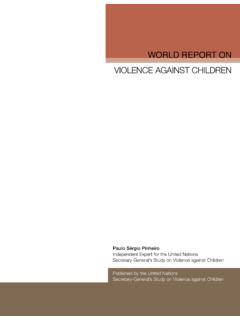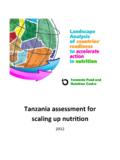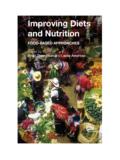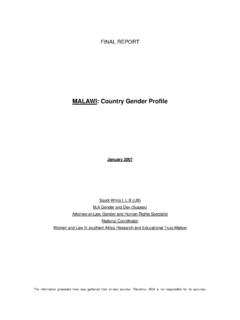Transcription of Children and Vulnerability in Tanzania: A Brief …
1 Child Mortality and MalnutritionChildren in tanzania face a high risk of deathat an early age, with more than 1 in 10 Tanzanian Children dying before they reach theirfifth birthday. This rate of under-five mortality means that160,000 Children under the age of five years dieevery year. Newborns face the greatest risk, withalmost 30% dying within one month of birth. Under-five mortality is estimated to be 112 per1,000 babies born, infant mortality 68, and neo-natal mortality 32 per 1,000 babies to quality health services and skilled carein health facilities at birth are critical in preventingthese deaths. Improvements in emergencyobstetric care are urgently needed to address thehigh maternal death rates, especially in the ruralareas, where only 39% of births take place in aChildren and Vulnerability inTanzania: A Brief OverviewApproximately 50% of the Tanzanian population over 18 million are aged under 18 years, with 77%living in rural large proportion of them are poor, malnourished and in ill health.
2 Theexperience of districts which have identified the most vulnerable Children within the context ofHIV/AIDS programmes suggests that overall about 6-8% of Children may be identified as the mostvulnerable Children about 1 million Brief highlights the key issues of Children and vulnerability3in Mainland tanzania . It provides anoverview of mortality, malnutrition, ill health, disability, orphanhood, HIV/AIDS, education, child labourand abuse. It is a summary of REPOA Special Paper Children and Vulnerability in Tanzania: A Brief Synthesis by Valerie Leach, a paper which was published with the assistance of UNICEF. 1 The United Republic of tanzania Population and Housing Census, 2002, Analytical Report, Volume X, National Bureau of Statistics, Ministry of Planning, Economy and Empowerment, Dares Salaam, August, 20062 Under international convention, as ratified by tanzania , a child is someone under the age of 18 refers to the risk of something negative happening, as well as the ability that the person can cope with the unfortunate event.
3 It is therefore the result not only of individualmishap, but also the social conditions which follow from systematic differences in the flows of resources and opportunities which themselves influence capabilities. All Children , especiallyyoung Children , are vulnerable because they depend on others to provide for their basic needs. (This definition is derived from REPOA Special Paper Developing Social Protection inTanzania within a Context of Generalised Insecurity by Professor Marc Wuyts).4 National Bureau of Statistics and ORC Macro, tanzania Demographic and Health Survey 2004-2005, December Aspects of ChildMortality and MalnutritionYoung Children are at greater risk ofmortality in some regions and districtsthan in others.
4 For example, the under-fivemortality rate is four times higher in Lindi andMtwara than in Arusha and Kilimanjaro. Onein four to five Children born in districts in Lindiand Mtwara die before their fifth birthday under-five mortality rates there are 220-250deaths per 1,000 live births; while in contrastthe districts of Arusha and Kilimanjaro record40 50 deaths per 1,000 live births. Analysissuggests that there are important geographicarea specific factors, beyond the commondeterminants such as level of education,income and risk of by grades, and result in the loss of7 12% of lifetime facility. 44% of rural women and 28%of urban women said that they have problemsgetting money to access health majority of child deaths under the age of5 occur in the rural areas, at 162 per 1,000live births, as compared to 123 for urbanchildren.
5 Malaria is the single most important diseasethat causes child mortality and malnutrition,affecting both Children and adults. In additionto malaria, diarrhoeal diseases and respiratoryinfections are also common among Children inTanzania. As with mortality, malnutrition is much moreprevalent among rural Children than theirurban peers. 38% of all Children under five 2million Children in total - are stunted. The rateof stunting is about 40% among all childrenexcept those who are in the least poor 20%of households, where the rate of stunting is16%. The rate of stunting among urbanchildren is 26%. Research shows that loss of stature at anearly age has long-lasting negative impactson a person s physical and cognitivedevelopment which are extremely difficult toovercome.
6 The long-term consequences ofmalnutrition can reduce the height of anadolescent by , reduce schooling2 Sources:National Bureau of Statistics, PopulationsCensus 2002 tanzania Demographic and HealthSurvey 2004/055 The United Republic of tanzania , Vulnerability and resilience to poverty in tanzania , the tanzania Participatory Poverty Assessment Main Report, 2002/03 ; Christiaensen L,and A. Sarris (eds) Understanding and Reducing Household Vulnerability - Evidence from Rural tanzania , report prepared for REPOA, December 2006; .Christiaensen, L, Towards an Understanding of Vulnerability in Rural Kenya a presentation to the PADI Conference, Dar es Salaam, February 20046 Alderman H, Hoddinott J, Kinsey B. Long-term Consequences of Early Childhood Malnutrition , Dalhousie University, Canada, November 20037 Smithson, P.
7 Fair s Fair , Women s Dignity Project and Ifakara Health Research and Development Centre, : Population Census, 20023 The Mainland Regions with the highest ratesof child mortality tend also to have thehighest rate of stunting in Children under-fiveyears; those with the lowest rates of mortalityalso have low rates of stunting in Children . Itshould be noted that analysis has shown thatgeographical patterns of mortality andmalnutrition do not correspond with thegeographical distribution of poverty. Anyprogramme aiming to address high rates ofchild mortality and malnutrition in specificgeographic areas needs to investigate thespecific factors relevant to that particulararea. For example, the regions of Iringa and Rukwawhich are among those regions considered tobe the highest producers of food in tanzania ,have relatively high rates of child mortality andmalnutrition.
8 In comparison, regions which areamong those frequently considered to beshort in food, Singida and Arusha (which atthe time of the Household Budget Survey in2000/01 included those districts which arenow in Manyara Region), have relatively highrates of food poverty (not enough food andnot enough money to buy food), but they alsohave relatively lower rates of under-fivemortality and inspection reveals that food productionis high in several of the regions with highrates of child malnutrition, and rates ofmalnutrition are low in many of the regionswhich are commonly associated with low foodproduction, and experience periodic droughtconditions. Therefore it seems likely that highrates of stunting may be closely associatedwith inadequate caring practices, includingfeeding and HIV/AIDSThe last Population Census in 2002 showed that nearly 10% of all Children in tanzania had beenorphaned close to 2 million orphans are more common of Children had lost their father, had lost their mother,and had lost both Aspects of Vulnerability for Children :Sources.
9 tanzania Demographic and Health Survey, 2004/055At an individual level, analysis indicates thatorphaned Children are poorer than childrenwho are not orphaned, and that the differencebetween the two groups is larger in Dar esSalaam than in other parts of the , no differences were found inhousehold living conditions and has focused much attention on theplight of orphaned Children , but increasingly ithas been recognised that Children areprofoundly affected by living with, caring forparents and other family members who aresick, dying. There are no nationallyrepresentative data to document the scale ofthe psychological toll on Children or its impacton them and their subsequent in Households Headed byChildren, or in Households withElderly Adults OnlyAccording to the 2002 Censusabout of the householdswere headed by a child.
10 Childrenwho head the household are onaverage between 14 and 15 yearsof age. Close to 3% of allhouseholds are occupied bychildren and the elderly (age 60years and above) only. These arehouseholds without any adult agedbetween 18 and 60 years of Children in such householdsare worse off than their peers inother urban households. In urban areas just over 30% of 15 year oldsliving in child-headed households are adult-headed households thecorresponding figure is 11% in Dar es Salaamand 18% in other urban areas. In rural areas44 and 34% of the 15 year olds in child andadult headed households respectively though they are more likely to beworking, the attendance rate in school ofchildren in these households is not differentfrom Children in other correlates show higher probabilities ofchild-headed households in the least poordistricts, an association which is stronglyinfluenced by the impact of HIV/AIDS.







